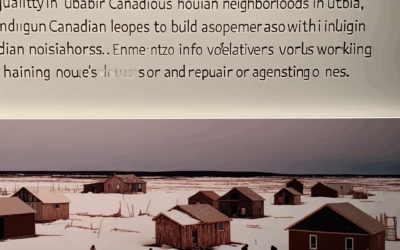Urban vs. Rural Housing Disparities in Canada
Introduction
Canada’s housing landscape is marked by stark contrasts between urban and rural areas, shaping affordability, availability, and quality of life for residents. While cities like Toronto, Vancouver, and Montreal grapple with soaring real estate prices and housing shortages, rural regions face challenges such as limited infrastructure and declining populations. These disparities influence economic opportunities, social services, and overall living standards. Understanding the root causes and implications of these differences is crucial for policymakers and residents alike. This article explores the key factors driving urban and rural housing gaps, from market dynamics and government policies to cultural preferences and migration trends. By examining these issues, we can better grasp the complexities of Canada’s housing divide and potential pathways toward more equitable solutions.
The Affordability Crisis in Urban Centers
Canada’s major cities are experiencing an unprecedented affordability crisis, driven by high demand and limited supply. Skyrocketing home prices and rental rates have pushed homeownership out of reach for many middle- and lower-income families. Factors such as foreign investment, speculative buying, and restrictive zoning laws exacerbate the problem. Meanwhile, rural areas often offer significantly lower housing costs, but this comes with trade-offs in employment opportunities and amenities. The urban-rural affordability gap highlights the need for policies that address supply constraints while ensuring rural communities remain viable alternatives.
Rural Housing Challenges: Beyond Affordability
While rural housing is generally more affordable, these areas face unique obstacles. Aging housing stock, inadequate maintenance, and limited access to financing make it difficult for residents to secure safe and modern homes. Additionally, rural communities often struggle with insufficient healthcare, education, and transportation infrastructure, discouraging potential migrants. Population decline further strains local economies, reducing investment in housing development. Addressing these issues requires targeted funding, incentives for remote work, and improved connectivity to make rural living more sustainable.
Government Policies and Their Impact
Federal and provincial housing policies have historically favored urban development, leaving rural areas underserved. Initiatives like the National Housing Strategy focus on increasing urban housing supply but often overlook rural needs. Tax incentives for first-time homebuyers and subsidies for affordable housing rarely account for regional disparities. A more balanced approach could involve tailored programs for rural housing rehabilitation, incentives for developers, and support for Indigenous housing initiatives. Without equitable policy adjustments, the urban-rural divide will continue to widen.
Migration Trends and Housing Demand
Internal migration patterns reveal shifting preferences between urban and rural living. While cities attract young professionals and immigrants seeking job opportunities, the rise of remote work has spurred interest in rural relocation. However, this trend is uneven, with some rural areas experiencing revitalization while others stagnate. Housing demand in urban centers remains high, perpetuating affordability issues, whereas rural regions struggle to attract long-term residents. Understanding these migration dynamics is key to planning future housing strategies that accommodate diverse needs.
Cultural and Lifestyle Differences
Housing preferences are deeply influenced by cultural and lifestyle factors. Urban dwellers often prioritize proximity to work, entertainment, and services, while rural residents value space, privacy, and connection to nature. These differing priorities shape housing markets, with urban areas favoring high-density developments and rural regions leaning toward single-family homes. Bridging this divide requires flexible housing solutions that cater to both lifestyles, such as mixed-use developments in cities and sustainable rural housing models.
Conclusion
The urban-rural housing divide in Canada reflects broader economic, social, and policy challenges. While cities struggle with affordability and overcrowding, rural areas face underinvestment and population decline. Government policies must evolve to address these disparities, ensuring both regions have access to adequate housing and infrastructure. Migration trends and cultural preferences further complicate the issue, demanding innovative solutions that balance density with sustainability. By fostering equitable development and supporting rural revitalization, Canada can create a more inclusive housing landscape. Ultimately, bridging the urban-rural gap requires collaboration, investment, and a commitment to meeting the diverse needs of all Canadians.



